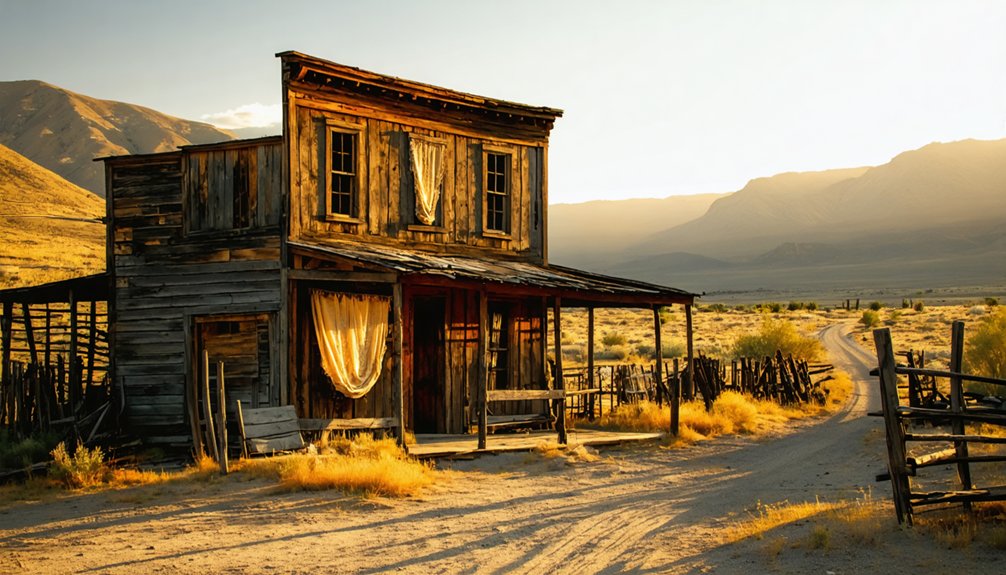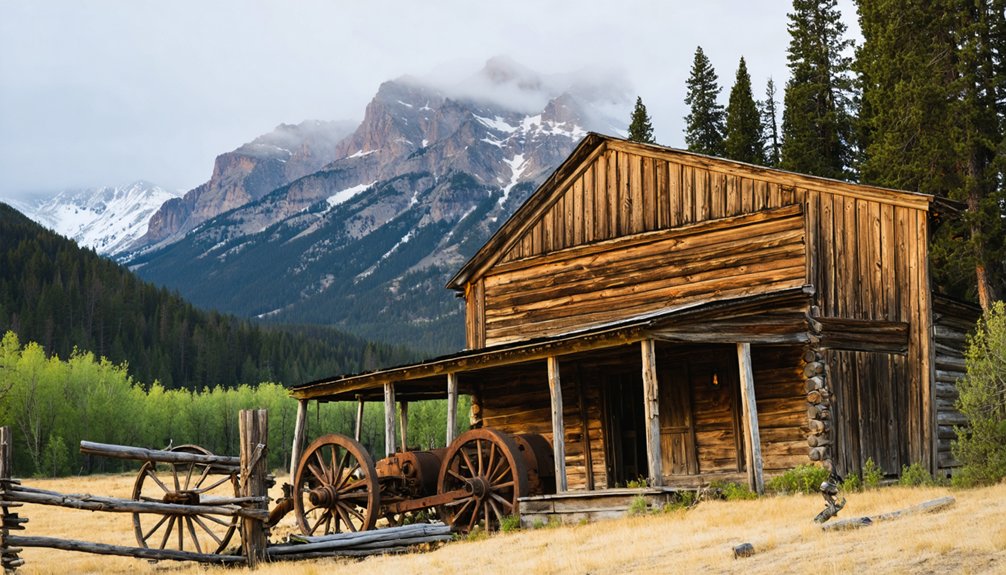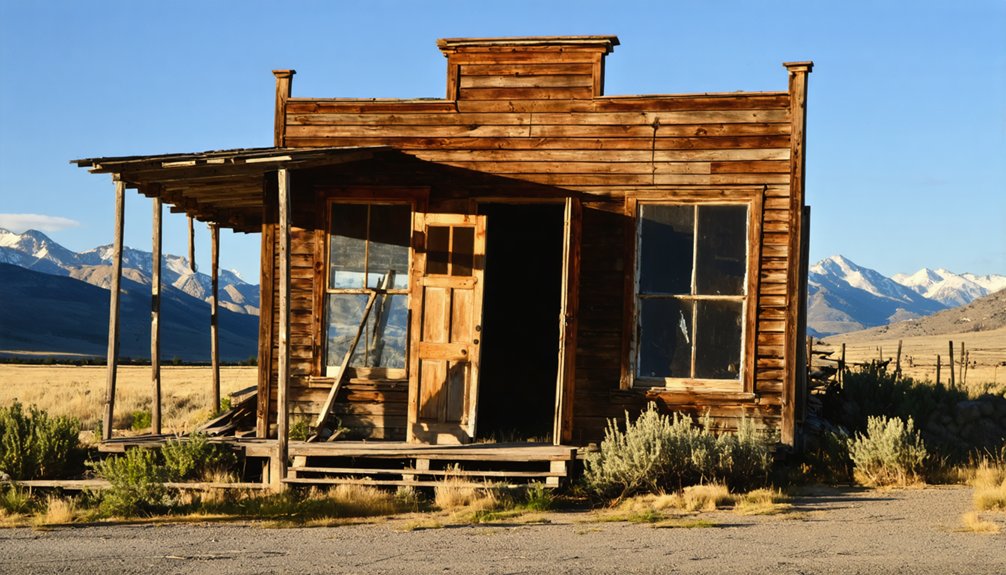You’ll find the abandoned mining town of Bonanza in Idaho’s remote Yankee Fork Valley, where an 1870 gold discovery sparked a dramatic boom. By 1881, over 600 residents called this frontier town home, with saloons, dance halls, and mines yielding thousands in gold. Today, you can explore the ghost town’s weathered remains, including the historic cemetery and distinctive dredge tailings. The site’s dark secrets and untold stories await around every crumbling corner.
Key Takeaways
- Bonanza became a thriving gold rush town in 1877 after gold discoveries in Idaho’s Yankee Fork area, reaching 600 residents by 1881.
- The town flourished through the late 1870s and early 1880s, producing significant gold yields before declining due to fires and depleted ore.
- Historic remnants include the Yankee Fork Gold Dredge, distinctive dredging piles, and a cemetery with weathered markers from mining days.
- Visitors can access Bonanza via Highway 75 northeast of Stanley, with a 10-mile road transitioning from pavement to gravel.
- Environmental impacts from mining operations persist, including soil contamination and acid drainage, with ongoing EPA remediation efforts.
The Birth of a Mining Frontier
When gold was discovered in Central Idaho’s Yankee Fork area in 1870, it sparked a series of events that would lead to Bonanza’s establishment in 1877.
You’ll find that William Norton’s remarkable 1875 discovery, yielding $20,000 in ore, drew prospectors from far and wide to test their luck in this promising frontier.
As miners flooded into the region, they faced frontier challenges like harsh mountain weather and remote conditions, yet their shared dreams of striking it rich fostered strong miner camaraderie.
The population was particularly diverse, with a high ratio of men to women, as prospectors from various ethnic backgrounds converged on this mountainous terrain. Most miners spent long exhausting days in the mines, making the town’s saloons largely empty after work hours.
Together, they built Bonanza into the area’s first significant settlement, laying the foundation for neighboring boom towns like Custer and Bayhorse.
The completion of the toll road in 1879 improved transportation and communication for the growing mining community.
Gold Rush Glory Days
As you explore Bonanza’s peak years, you’ll find that the 1879 gold rush transformed a tiny settlement into a thriving frontier town where miners extracted over $40,000 in gold from Norton’s water-powered arastras alone.
The rush of wealth attracted countless prospectors who lined the roads to Yankee Fork by foot, horseback, and wagon, reminiscent of the famous Pike’s Peak stampede. Like the Boise Basin bonanza, these mines drew thousands seeking their fortune in the rugged wilderness.
The town’s saloons and store buzzed with activity as daily mining yields averaging $8 per claim created a bustling social scene where miners spent their newly acquired fortunes. By 1881, Bonanza reached its peak with over 600 residents and boasted several thriving businesses including a dentist, watchmaker, and the county’s first newspaper.
Mining Wealth and Prosperity
The discovery of gold near Yankee Fork in the late 1870s transformed Bonanza from a modest settlement into a thriving boomtown.
Using primitive mining techniques like water-powered arastras, early prospectors extracted impressive amounts of gold – $33,400 in 1878 and $40,000 in 1879. Higher-grade ore from nearby mines added another $25,000 to the region’s wealth.
The economic impact was immediate as thousands of experienced miners from California and Oregon rushed to stake their claims.
You’d have seen the roads crowded with fortune seekers traveling by foot, horse, and wagon.
While early placer mining proved profitable, it was the introduction of the massive Yankee Fork Gold Dredge in the 1930s that sustained the region’s prosperity, reportedly recovering up to $16 million in gold during its operation.
Much like the Ponderosa Ranch’s vast territory in Nevada, the mining claims around Bonanza stretched across thousands of acres of rugged terrain.
Saloons and Social Life
During Bonanza’s gold rush heyday, saloons served as the beating heart of the community’s social and business activities. You’d find miners, merchants, and townspeople congregating at establishments like the Arcade Billiard Saloon and Yankee Fork Dance Hall, where deals were struck and news spread freely.
The saloons culture extended beyond just drinking – these venues hosted community gatherings and functioned as informal meeting spaces. The town’s toll road to Challis helped connect these establishments to neighboring communities.
Notable proprietors like Lizzie King, a golden-haired beauty, challenged traditional roles by running successful saloons and dance halls. Some establishments even doubled as general stores, letting you purchase both liquor and supplies under one roof. The combined saloon and general store included residential quarters in the back section.
This vibrant social scene thrived until devastating fires in 1889 and 1897 destroyed many saloons, marking the beginning of Bonanza’s decline as residents relocated to nearby Custer.
Life in a Wild West Boomtown
You’d find Bonanza’s bustling social scene centered around the Charles Franklin House dance hall, baseball field, and numerous saloons where miners spent their hard-earned gold.
While the town lacked formal law enforcement, its 600 residents managed their conflicts through a mix of community standards and frontier justice, as evidenced by the sobering presence of Boot Hill cemetery.
The boomtown’s economy created both instant wealth and crushing losses, with merchants and service providers often faring better than the miners who faced dangerous working conditions in their pursuit of precious metals. The extreme Idaho climate made life especially challenging, with harsh winter conditions lasting from October through May.
Daily Social Scene
Life in Bonanza revolved around a vibrant social scene shaped by mining families and diverse cultural influences. You’d find yourself mingling with immigrants from London and miners of various backgrounds at the Arcade Billiard Saloon, where community gatherings were a daily fixture.
After long days at mines like Lucky Boy or Black Mine, you’d join your neighbors for evening entertainment and socializing. Residents would often gather for lavish dinner parties, following the traditions of more prosperous mining towns.
Family traditions took center stage in this close-knit community. You might spend weekends exploring the surrounding wilderness on horseback or attending local events with other mining families.
While the town lacked a formal church, you’d participate in civic gatherings that strengthened community bonds. The local school served as another social hub, where children and parents alike would come together, reinforcing Bonanza’s tight-knit character.
Law and Order Struggles
While Bonanza’s mining operations boomed, the town struggled with widespread lawlessness and corruption that peaked under Sheriff William Updyke‘s administration in 1865.
You’d find Updyke’s criminal faction controlling both the town and county, running schemes like passing counterfeit gold dust and extorting illegal “taxes” from local businesses while protecting their political allies. His experience as a stage driver in California prepared him well for organizing transportation-related crimes.
With law enforcement compromised, you’d witness citizens taking matters into their own hands through vigilante justice.
These vigilance committees captured and executed notorious criminals, including the hanging of outlaw Fred Williams. They eventually cornered Updyke himself at Sirup Creek, forcing him to flee.
The volatile mix of gambling halls, rough miners, and traveling saloons created a crime-prone environment where outlaw gangs operated freely, often in collusion with corrupt officials.
Making and Losing Fortunes
The discovery of gold near the Yankee Fork River in 1876 sparked a classic Wild West tale of rapid fortunes won and lost.
You’d find entrepreneurs like Charles Franklin capitalizing on the rush by selling real estate lots and establishing businesses to serve the growing population.
The economic volatility of mining life was evident in Bonanza’s boom-and-bust cycle. While some struck it rich in nearby mines like Lucky Boy and General Custer, others built their wealth through supply stores, boarding houses, and restaurants.
Chinese immigrants contributed to the entrepreneurial spirit, establishing businesses in neighboring Custer.
But fortune’s wheel kept turning. By the late 1880s, fires ravaged the town, ore veins depleted, and miners drifted away.
What began as a promising boomtown with 600 residents in 1881 became a ghost town by 1910.
Tales of Love, Murder, and Mystery

From its earliest days, Bonanza harbored dark secrets of love, betrayal, and murder that would shape the town’s legacy.
In 1878, Lizzie and Richard King arrived in Bonanza, where a complex love triangle emerged between them and town founder Charles Franklin. The story took a deadly turn when:
- Richard King became entangled in a land dispute with William Dillon
- Dillon murdered King on July 14, 1879
- Lizzie selected her husband’s burial site with Franklin’s support
- The murder mystery deepened with three unmarked graves in “Boot Hill” cemetery
The town’s residents avoided “Boot Hill” due to superstitions about the spirits of those buried there, including Lizzie and her two husbands.
This tale of passion and violence remains woven into Bonanza’s ghostly folklore, a reflection of the raw emotions that shaped frontier life.
Environmental Legacy of the Mining Era
Beyond Bonanza’s haunting tales of frontier justice lies a more tangible ghost – its environmental footprint.
You’ll find the area’s mining legacy in its contaminated soil, water, and air, where heavy metals like arsenic and mercury persist from historic operations. The waste dumps and tailings continue to leach toxins into local streams and groundwater, while fugitive dust can still become airborne despite vegetation cover.
You can spot signs of environmental contamination at the Bonanza Tunnel, where acidic drainage leaves orange precipitates.
The EPA’s stepped in with extensive remediation efforts, including waste rock removal and protective soil capping. While ecological restoration efforts have made progress through contamination control and habitat recovery, the ghost town’s industrial past remains etched in its landscape, requiring ongoing monitoring and management.
Exploring the Ghost Town Today

Accessible via a well-marked junction off Highway 75 northeast of Stanley, Bonanza ghost town sits at the end of a 10-mile stretch that begins with pavement and shifts to gravel.
As you approach, you’ll notice distinctive piles of river stones from historic dredging operations lining the roadway.
For safe ghost town exploration, follow these essential guidelines:
- Stay outside the dilapidated structures, which are unstable and filled with mining-era debris.
- Keep a safe distance from scattered mining equipment and artifacts.
- Visit during dry conditions when the access road is most manageable.
- Photograph from safe vantage points while respecting private property signs.
The nearby cemetery, accessible via a rougher gravel road, offers a glimpse into the town’s past through its weathered markers and informational signboard.
Frequently Asked Questions
What Happened to the Native American Tribes in the Bonanza Area?
You’ll find Native tribes in the Bonanza area were forced onto reservations like Fort Hall after the Bannock War of 1878, causing lasting historical impact through displacement and cultural disruption.
How Much Gold Was Extracted From Bonanza’s Mines in Total?
You won’t find exact figures for Bonanza’s total gold extraction, as historical records don’t separate its output. While Idaho produced 8 million ounces overall, Bonanza’s specific mining yields remain undocumented.
Were There Any Famous Outlaws or Lawmen Associated With Bonanza?
You won’t find any famous outlaws or notable lawmen in the town’s history. The only documented crime of significance was Richard King’s 1879 murder by William Dillon over a land dispute.
What Was the Average Daily Wage for Miners in Bonanza?
While exact figures aren’t documented, you’d find mining wages were particularly high due to labor conditions in remote areas. You’re looking at above-average rates compared to other regional mining districts.
Did Any Significant Archaeological Artifacts Survive From Bonanza’s Heyday?
You’ll find limited archaeological significance at Bonanza due to two devastating fires. The cemetery, scattered mining equipment, and degraded building foundations represent the main surviving artifacts, with poor overall preservation.
References
- https://westernmininghistory.com/towns/idaho/bonanza/
- https://www.legendsofamerica.com/id-bonanzacuster/
- https://pinintheatlas.com/travel-blogs/ghost-towns-of-idaho/
- https://www.youtube.com/watch?v=je9412S4LCs
- https://idaho.com/history/bonanza/
- https://www.tripadvisor.com/Attraction_Review-g28933-d1775240-Reviews-Bonanza_and_Custer_Ghost_Town-Idaho.html
- https://www.youtube.com/watch?v=6hlviqR8cbk
- https://www.idahofriends.org/uploads/5/2/5/3/52533793/yankeeforknarrative.pdf
- https://npshistory.com/publications/nhl/theme-studies/mining-frontier.pdf
- https://www.ushistory.org/us/41a.asp



